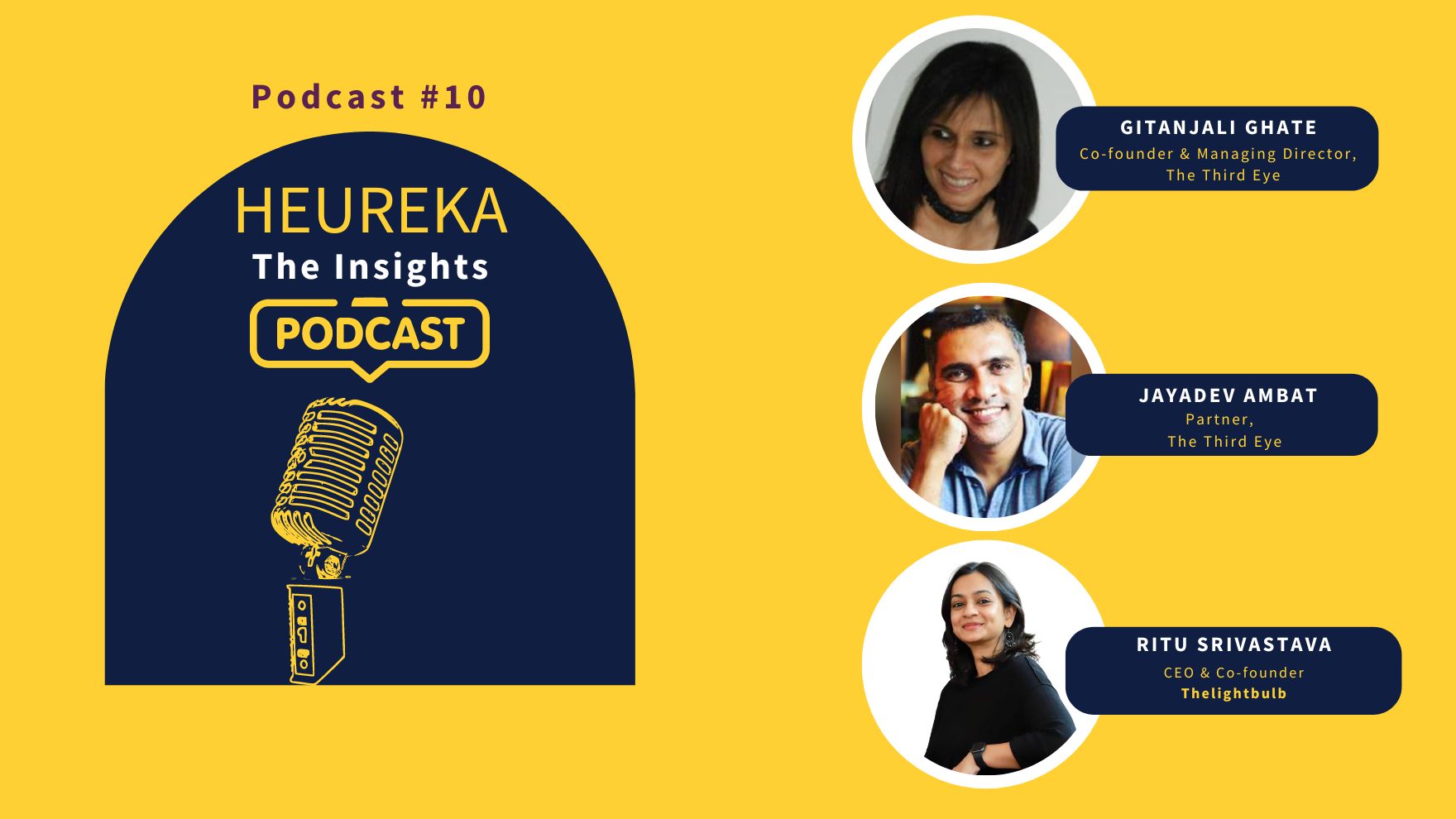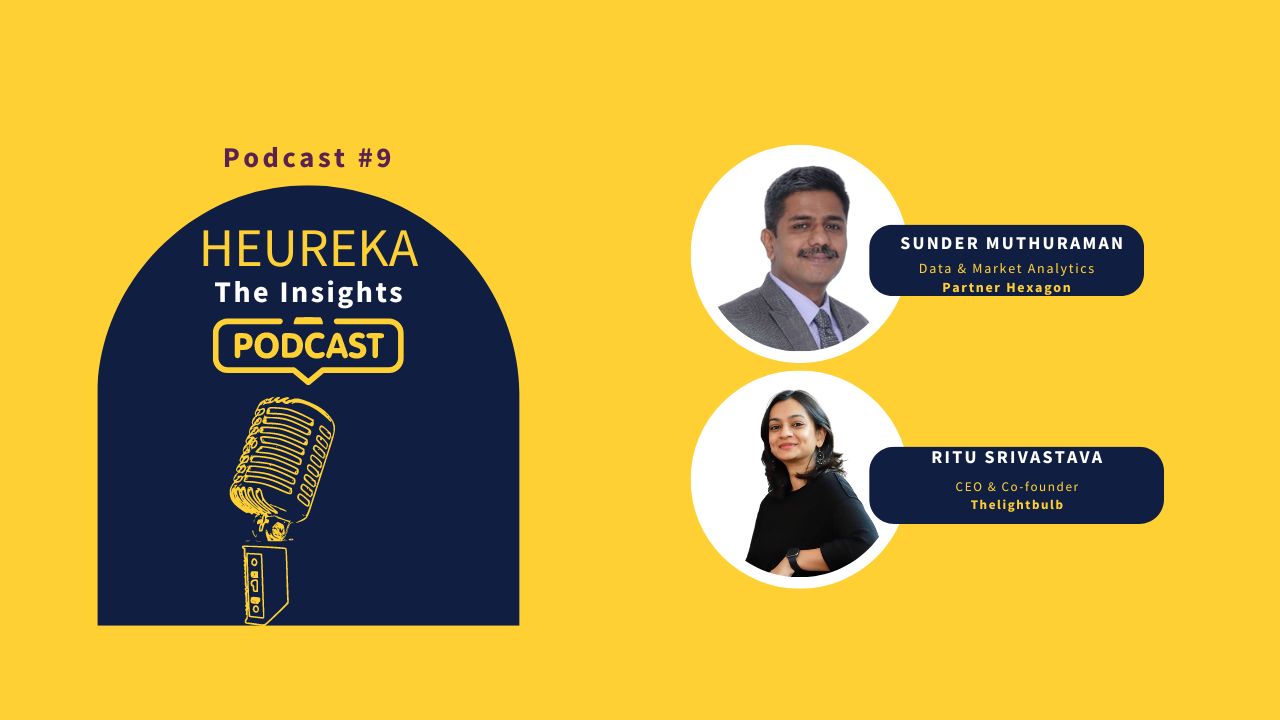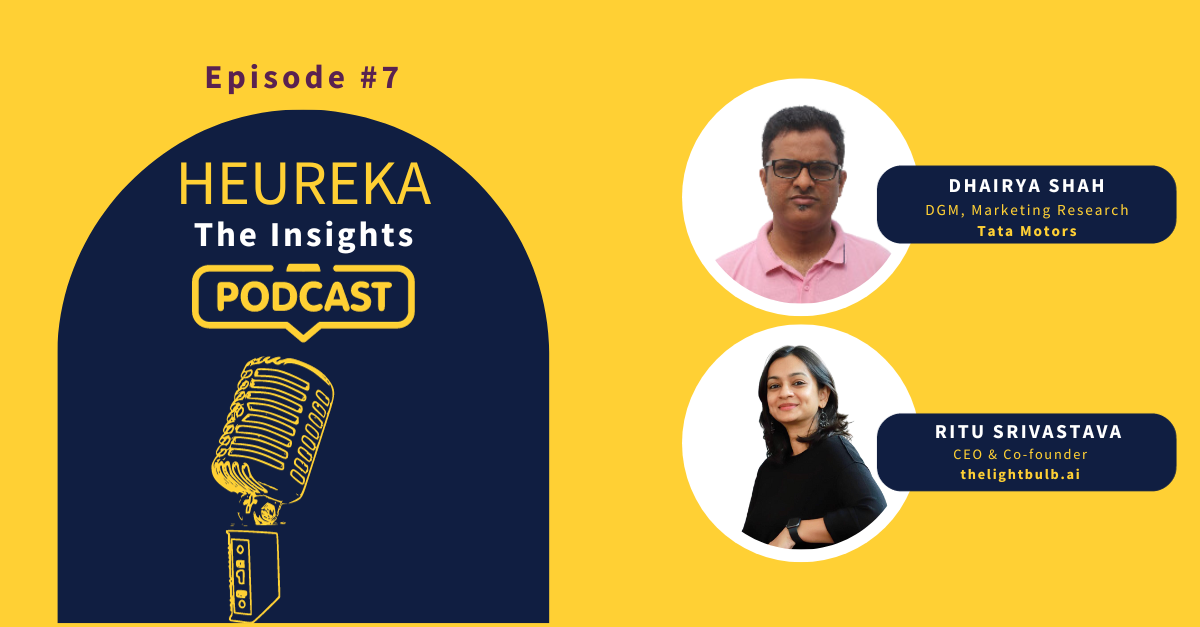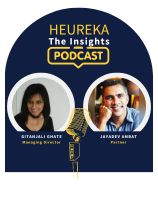Ep #8 – Shibarjun Ghosh on Insights in the Entertainment Industry
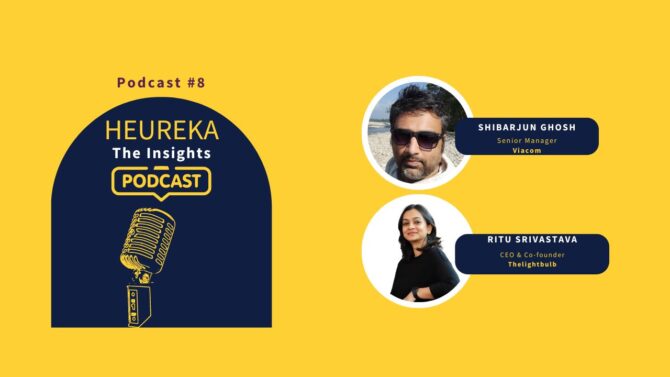
Welcome to the eighth episode of ‘Heureka – The Insights podcast’ by thelightbulb.ai.
In this episode, we are hosting Shibarjun Ghosh from Viacom18, an accomplished qualitative researcher with significant stints in Kantar, Nielsen and other leading MR agencies. Listen to the full episode here.
Guest: Shibarjun Ghosh
Shibarjun Ghosh is a seasoned qualitative research professional with a proven track record in extracting actionable insights to inform strategic decision-making. Currently serving as Senior Manager – Qualitative Research at Viacom18 Media Private Limited, Shibarjun plays a pivotal role in designing and executing impactful research projects.
In his previous role as Manager at NielsenIQ, Shibarjun contributed significantly to the research team by managing and executing qualitative research initiatives. At Kantar, as a Senior Research Manager, he led qualitative research projects, enhancing the company’s methodologies. Additionally, his experience at Karvy Insights Limited and Vox Populi Research involved end-to-end management of research processes and client satisfaction.
During his tenure at Purple Audacity Research & Innovation Pvt. Ltd, Shibarjun showcased expertise in leading research initiatives, demonstrating professionalism, and contributing to project success. In earlier roles, he worked as an Independent Consultant in Freelance Research and held positions as a Research Associate, Research Consultant, and Research Executive.
Shibarjun’s key skills include qualitative research, project management, data analysis, client relationship management, and team leadership. Committed to staying current with industry trends, he leverages his extensive experience to drive success in future endeavors. With a career spanning Viacom18, NielsenIQ, Kantar, and other reputable organizations, Shibarjun brings a wealth of knowledge and expertise to any research-focused role.
Host: Ritu Soni Srivastava
Heureka – The Insights Podcast is a series of podcast episodes hosted by Ritu Soni Srivastava, who is a seasoned entrepreneur, focused on her current startup thelightbulb.ai, a full-stack emotion ai platform for digital interactions that has scanned more than 8 million faces for emotion analysis. She has held pivotal profiles across deep-tech, health-tech, telecom and media companies over the last 20 years. Her cross-industries experience gives her a unique edge in understanding consumer trends and insights across verticals.
In the podcast, Shibarjun shares some interesting experiences, challenges and solutions of working from agency as well as brand side.
Engagement and Sentiment Analysis of Podcast
Note: Engagement and sentiment analysis are generated using thelightbulb.ai’s Insights Pro

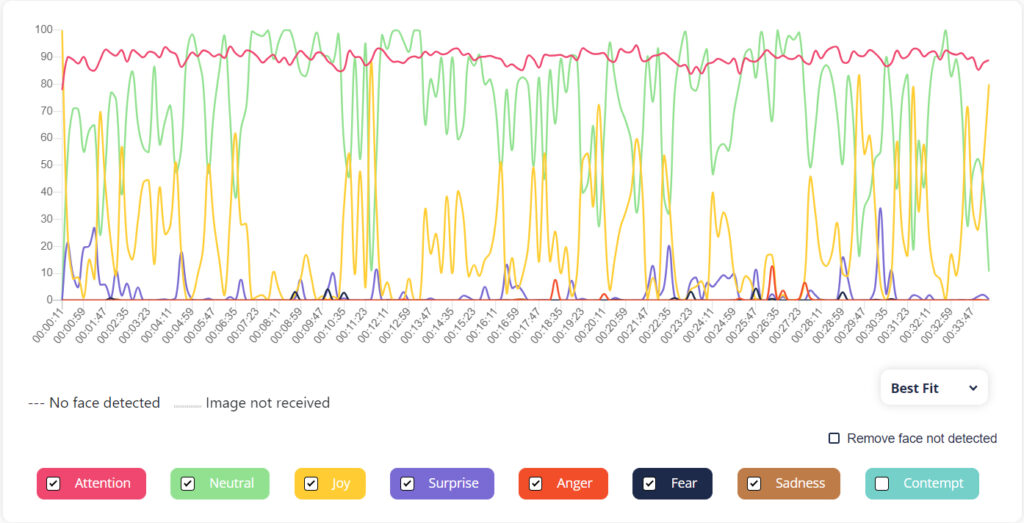
Voice Transcripts of Podcast
Note: Transcription of the podcast is generated using thelightbulb.ai’s Insights Pro
Heureka by thelightbulb.ai, The Insights podcast.
Ritu Soni Srivastava: Hi, everybody, and welcome to yet another episode of Hureka, the Insights podcast. We have a very special guest on with us today. We have Shibarjun Ghosh, who leads consumer insights for Viacom 18 and comes with a very long lineage of research experience. He’s been with Kavi.
Ritu Soni Srivastava: He’s been with Kantar. He’s been with Nielsen. And now he’s on the agency side, looking at possibly one of the largest entertainment companies, and they’re varied requirements from research perspective. And I think what we’re really excited to have Shibarjun today with us is that entertainment, especially streaming services, are now taking a very, very large place on the entertainment landscape, not just in India, but globally. And Shibarjun is one of the first people on our podcast who represents this genre, and we would love to delve a little deeper into his experience and the kind of insights that he’s had selling to a market as large and varied as India from the perspective of somebody who builds entertainment for different audiences of different segments, vernacular origins, and other segmentations. Thank you so much for being with us today and taking the time out on this
Shibarjun Ghosh: My pleasure My pleasure and very good morning to you as well.
Ritu Soni Srivastava: Thank you so much
Ritu Soni Srivastava: Though I have introduced you briefly, I think it would be lovely for all of our listeners if you could just take us , uh, through a quick recap of your work experience, how you came to be in this space and the work you do currently.
Shibarjun Ghosh: Sure. Sure. Sure. I would I would do that. A bit of a disclosure before we start is, whatever I say is my own personal views.
Shibarjun Ghosh: It does not reflect the overall policy of our committee. And and, another thing is, I am part of, the regional cluster of general entertainment business of Viacom acting. It’s not the overall Viacom acting. They have multiple departments and multiple verticals. Different teams lead that.
Shibarjun Ghosh: I am part of the Bengali regional cluster. I’m based out of Kolkata. So having said that, I’ll I’ll start with, how I ended up in market research. It was, after my b school, during the compassing, so there was an agency by the name of Coral Research. This was in 2011.
Shibarjun Ghosh: So they had come in, and we had tests, we had internal tests and all. So, there were interviews, multiple rounds, and I qualified for that. And there, I was supposed to shift from Kolkata to Delhi, so this was a big opportunity for me. So that’s how I got initiated into the field of market research, but, the way was rather convoluted than straight for me. After a few, months into market research, I decided to give a shot at UPSC, which I could clearly could not qualify.
Shibarjun Ghosh: And, then I had a very good opportunity of working at Purple Audacity. So Purple Audacity is headed by Sharmila Das, one of the official legends. She has been conferred one of the title of legend by, I think, ESOMAR. So, I I was very, very lucky to work under her, for 2, two and a half years. She took me under wins, taught me from the very basics, was a fantastic experience, a very tough experience, but a fantastic experience.
Shibarjun Ghosh: She is, one of the stalwarts of the industry, and it was great to learn from her. And then I went on to work for, Vox Populate. There also, I worked with Rajee Bonala with another, stalwart of the industry. Then happened, and then I had to move to Kolkata for which I used to work with IMRB. IMRB now is Cantor, of course.
Shibarjun Ghosh: And then after around 3 years at Kantar, I moved to Nielsen and then Viacom. So it has been a long journey for me. And now finally, I get to see the other side of it, working on the client side.
Ritu Soni Srivastava: And how has that experience been? What has been for you? I think, the most marked change in moving from an agency culture to a brand culture?
Shibarjun Ghosh: Ritu, first of all, the experience is shaped by people that you meet along the way. More than, the change of space, of course, it brings in with it some changes, but it’s the people along the way that you meet. And I have been very, very lucky to meet some amazing teachers, amazing friends, people who teach you, people who teach you how you look at market research, how you look at work, how you look at life. I have been very fortunate. Sharmila has been one such person.
Shibarjun Ghosh: Raji has been one such person. Sushmita, Vivek, Vivek is in Google now. Sushmita was at Kavi. McNeal Chaudhry, Ria at IMRB. Fantastic teachers.
Shibarjun Ghosh: And, these are the people that I would remember after years because you don’t remember the projects that you work on. You don’t remember the studies, the findings, the insights. What you remember are the people and the experiences you have along the way. And I’ve been very, very lucky to have met such people. It has been fantastic.
Shibarjun Ghosh: The learning is huge on the agency side of it. The thing is there are a few interesting areas. Few, I would say, the things are more interesting on the client side. The interesting thing about working on the agency side is you get to work on a lot of categories. There is a huge mix.
Shibarjun Ghosh: Today, you are working on FMCTG. Tomorrow, tobacco. Then you work on auto. Then you work on, something else. So the mix is very exciting.
Shibarjun Ghosh: It’s never one moment of monotony. And you get such wonderful mentors to work with. That’s fantastic. On the client side of it at Viacom, you again have fantastic people there. I was very fortunate to work under mister Shagney Ghosh, who, was heading star, who was once heading star, then he came to colors, and then we, mister, another, veteran and stalwart of the industry, Krishnendu, was there, who is again, heading strategy for, Star, now.
Shibarjun Ghosh: So I have had this wonderful opportunity of being under some very, very interesting, very supportive people. But the feel on the, client side is you are the custodian of everything that happens for one particular category. So you get to see from the start to the end of entire research, journey, which you do not at times get to see on the agency side. Just to give you an example, on the agency side might be, you get to do a promo or an ad evaluation, and you don’t have much clue what happens after that if you are not part of the study. But over here, you are part of, from understanding the concept generation evaluation from there to, doing the evaluation of the promos that comes in, then the final product goes into the market.
Shibarjun Ghosh: You are part of that as well. And not only evaluation, after a certain point in time on the client side, you also get to be a part of the brainstorming and ideation team in the, whatever cluster that you are working on. So other than only having a third person’s perspective, which you get on the agency side, over here, you also contribute from your understanding as how people might potentially react. You have your research to understand that finally, but over here at the brainstorming initiation, jam ideation, stage itself, you are the voice of the consumer. So there are a lot of editing that happen at the brainstorming stage itself because you deal with a lot of creative people, and creative people are what tends to happen is if you if there is no check and balance, thing get a very lopsided view.
Shibarjun Ghosh: So you are the consumer’s view, because from your past experience of a certain type of thing, you know that certain type of thing, get a certain type of reaction. Then you bring that view onto the table, and that is very important, I guess. So that’s how I think, broadly differ. You have, interesting things on both sides.
Ritu Soni Srivastava: Absolutely. I think one of the things that, we get asked a lot by, you know, because we’re a start up, the investment community, very often ask us, where is the ROI? How do you measure the ROI on research? And one of our, you know, common, rebuttals to that is we are part of the inciting process. But the implementation of those insights or those recommendations and the business impact it does doesn’t necessarily flow back to either the agency or a technology partner like us.
Ritu Soni Srivastava: So I think where you come from, where you’re able to see the end to end movement from what was the problem to how did those recommendations get applied and how did it really move the needle for the business team must be a very, very satisfying process to kind of watch.
Shibarjun Ghosh: It’s very satisfying, gives you a sense of closure, something that we are the in, agency and attempt to just talk about amongst ourselves. Key, suppose we do a concept evaluation, and then we did not see the same in the market in the next few months. Maybe something else was launched, and we were not part of that study. And then we did a promo or a ad evaluation for the other product. So we had no clue as to how that thing is evolving in its at the back end.
Shibarjun Ghosh: So, this is a very, satisfying thing of working on the client side that you have a full view of how things are shaping up at the back end.
Ritu Soni Srivastava: Lovely. So, Shiv, tell me what your day to day looks like. What does a normal day in your life look like? Like, you get to office and then what?
Shibarjun Ghosh: Well, if you are working in the television industry, there are Thursdays and there are other days. So Thursdays are the number days. So that’s a hurricane day for most of us because the numbers come in, the BART numbers come in. So that decides, a lot of tactical and sometimes strategic changes for your team, something that needs to be taken at a very quick without much, delay. Some decisions A lot of decision decisions happen on Thursdays because you do certain things, and then you finally get to see how the viewers have taken to it.
Shibarjun Ghosh: So that’s a result. And then, on other days, what mostly happen is, we start the week with the Huddl. We have an intraday Huddl and then our larger team Huddl. We, for the research, team I can give you a better picture for the research team. What happens is we talk with, within the team.
Shibarjun Ghosh: We take stock of what are the things that needs to be done. So what needs to be the done, there are a lot of studies going on. Some of them are larger studies, for strategic changes, maybe consumer understanding societal trends. These are larger macro studies. And then you have smaller studies happening, simultaneously on the side, which are more for tactical reasons, tracking the shows, tracking the tracks of the shows that you are working on because a story has multiple tracks.
Shibarjun Ghosh: Some of them get traction. Some of them don’t. So, we have to be in constant, evaluation of that process. And, then you, at times, are pulled in for putting in your views for concept germination, concept initiations. So maybe the programming team comes in with something.
Shibarjun Ghosh: We have this. I will not get into details about what those these are. Audience might react to it. How do you think this is something this is a probe that we have tried in the past, products. This is something that we have not been able to get traction on, but this is something we are packaging in a new way.
Shibarjun Ghosh: So how do you think it might pan out? So I give my, views on that, and, at times, your views are also taken into consideration for ideating on future story, story or concept approaches. So these things keep happening. So Mondays are mostly for taking stocks on the previous week, setting agendas for the week, getting in touch with other departments like the programming, the marketing. And marketing also has a lot of events that are happening.
Shibarjun Ghosh: And being into qual research, you have to get into the field. So the more you talk to people on the field, the more of a pulse that you get. And then Fridays are, we again end that week with the Huddl, take stock of how things panda for the week, and, anything that we need to put on agenda for the next week. So this is how it mostly looks.
Ritu Soni Srivastava: So a busy week. I I loved your statement about Thursdays.
Shibarjun Ghosh: Yeah. And and one more thing, Ritu, is, if you are into qualitative research for media or a storytelling organization, one very important thing that you have to do is be in sync with whatever is being played on your channel or your platform. You have to be an audience of that because what happens is at the very beginning of my, journey in qualitative research, I have been taught, that, a golden rule for qualitative research is not everything that is said means, and not everything that is meant is said. So it’s very important to read between the lines. And you can read between the lines only when you personally have a very good grasp on the content that is playing out.
Shibarjun Ghosh: So if you only are aware of the concepts that are playing out and you are busy in your meetings, but you do not if you are not in touch with the content that is being played out on TV or on digital day in, day out, you might not be in a very good position to interpret what the viewers are saying. So that is, again, a very important part of what we have to do. So, yes, we are paid to watch, programs. So that is a part of it, but not all of it.
Ritu Soni Srivastava: But I think every cook has to eat their own cake. Otherwise, how do you know, you know, what you’re putting out there? No. Absolutely. And I think one of your lines on, you know, whatever is being said is not all that is being said.
Ritu Soni Srivastava: There’s much to see under what is being said It’s a very natural segue into the question I want to ask you next. You know, we represent an emotion AI organization, And that’s just the tip of the iceberg when it comes to now the market research technologies that are starting to become available to brands and agencies. What is your view overall on the technology transformation that’s happening in the market research space? What are the trends that are standing out for you as something that has potential in the future?
Shibarjun Ghosh: Well, this is something I would want to learn more from you than me putting up my views. I have some views. I’ll share that, but I would want to know more from you, especially given the fact that you are having a very, holistic view of a view of what how technology is affecting or maybe disrupting the entire industry. That is something I would want to know from you. From my perspective, from my limited learning, whatever I have gathered is there are a lot of interesting tools that are coming up.
Shibarjun Ghosh: I have seen your presentation on the MRSI seminar that your team had put up, and I found it very interesting. There were few aspects that I could not get the full grasp of, but I found, it very interesting. And even we had a chat prior to that regarding how your, product could be held for us. Right now, amongst the things that we are doing, we did not find it to be an exact fit for what we are looking for. But in the future, you never know because it’s a very interesting thing.
Shibarjun Ghosh: It’s, it saves a lot of time. It, what it does, it it helps to crunch a lot of data, in a small period of time. Then what it does, it it gives you as a researcher some time to brainstorm around what has come across. You might contradict to with it. You might agree to it, but it gives you that bandwidth, which at times we grapple with.
Shibarjun Ghosh: That is, one very interesting thing, which I found about it. For qualitative research, something that I am a part of, I think there will be this dichotomy, especially after COVID. How much tech is too much tech? Are we losing the personal connect? That, debate will always be there.
Shibarjun Ghosh: I am someone who is a bit old school, having been mentored by, people like Sharmila, McNeal, Raji, and all. I come from their school of market research who put a lot of, lot of emphasis on meeting the consumer face to face at their homes, at their places of work, and a lot of things are conveyed by gestures. Your reluctance to say something might say more than what you actually are saying about it. So these are, very subtle cues that you have to pick up on. And, I think this is something that, where personal interventions, personal involvements would weigh in heavily for the future if this is the path that we want to go.
Shibarjun Ghosh: The tech part of it would come into, I guess, crunching a lot of data. What, we are not a well, we are not a quantitative There would be a daylight gap in the actual intent of a user when someone says fantastic or someone says good. So, you have to learn to read between the lines where I think, tech technology or AI would help us is crunching the data in a in a form where we can take our call. So that is one area I think, a lot. I think you being in a very advantage position to, talk on it, I would want to also hear your point of view, how you foresee technology, making a dent in qualitative research.
Shibarjun Ghosh: Quantitative research, I get it’s more linear. Qualitatively research, there is a lot of reading between the lines. So how do you think I would want to get your point of view?
Ritu Soni Srivastava: Thank you so much. I think very few people have asked me that. So happy to elaborate. I think you’re absolutely right that quantitative research is quite time consuming because the actual process of research itself is extensive and then the data to process is even more extensive. So 100% are technologies like ours and others in the market help you in crunching that data, extracting patterns, trends, word clouds, you know, just basic data crunching and sorting so that the researcher can spend more time in tuning rather than parsing data.
Ritu Soni Srivastava: So one of the things that we’ve seen in in and we work with a lot of agencies including Kantar and Nielsen on qualitative research. In fact, McNeal was the person who first bought us into Kantar. He spearheaded our first, you know, initiative. So huge risk.
Shibarjun Ghosh: He’s he’s one of my mentors, a guru, someone I look up to, absolute inspiration.
Ritu Soni Srivastava: He is. He really is. I think he has the ability to look far ahead into the future and identify things even before they become a disruption or a wave. So huge amount of respect there. And I think one of the values that we were able to add to Kantar was crunching, a lot of the data in almost 1 6th the time it typically takes a qualitative research.
Ritu Soni Srivastava: And like you very rightly mentioned at the MRSI seminar, one of the reasons we kind of got nominated for that research paper was the ability of the AI platform to spot nonverbal cues indicating exactly what you said. You know, when somebody is, stating a brand preference, the actual brand preference may be different, and the nonverbal cues give it away. And I think that really, in addition to crunching time, is something that AI brings to the table, is that it spots patterns in gestures, expressions, behavior, which it can then highlight to the researcher. Because what we always say as a team is we can’t supplement the I mean, we can’t really replace the research process in any way. We can supplement it.
Ritu Soni Srivastava: We can speed it up. We can aid the researcher, but we very, very strongly believe as a team that the researcher is quintessential to the research process. Because only a human being truly understands the behavior of another human being. You know, you can train systems, but they cannot replace a human being. We can aid them to become faster, better, stronger, but we can’t replace the process.
Ritu Soni Srivastava: So thank you so much for giving me an opportunity, you know, to say that. There’s a deepest respect for the market research process and the inciting process, despite the fact that we build technology that, you know, in some way seeks to aid it. So thank you so much for that.
Shibarjun Ghosh: Thank you, Ritu. Thank you, Ritu.
Ritu Soni Srivastava: Let me now ask you about the next question that’s been kind of on my mind. You’ve been now in the industry for almost a couple of decades. You’ve seen agents
Shibarjun Ghosh: Not really, I think about 10 years now.
Ritu Soni Srivastava: Okay. It’s a dead decade. And the last decade has been the most disruptive when it comes to not just COVID happening, AI technology hitting the system, massive restructuring and changes in the economic environment. What is your sense? How has the industry really changed from the time you joined it to now?
Ritu Soni Srivastava: What is the most striking change or difference that you have seen impacting the research industry?
Shibarjun Ghosh: One very important trend that I have seen is the type of people who are joining the industry. The young, the newbies. This see, for me, for someone like me or people who had joined during my time, we were it was more of a learning on the job rather than having with rather than coming with a training for market research per se. But the people who are joining are very different. They have a strong grounding in the academic part of what we do.
Shibarjun Ghosh: They joined the industry because they wanted to join the industry. You for someone like me who drifted into market research, I think people now are taking a conscious call. I want to join the market research industry. And for that, what they bring to the table is a lot of grounding in strong academic foundations, sociology, anthropology, behavioral economics. These are things that I have learned on the job.
Shibarjun Ghosh: These are very important aspects that gives you, a lens to look into your viewers or users, consumers, people that you are the subject of your study. The people who are joining now have a lot of training already into this field. So they are bringing with them a lot of rigor into the academic aspect of it. And, this is very interesting, I would say. Another interesting aspect that I have seen is, the emphasis on storytelling.
Shibarjun Ghosh: What I have seen over the period of time is, the PPTs, were your final outputs. It used to go as a document of your finding. Then over a period of time, what I started noticing is one very important, one very important thing that a client, I used to handle long back, said, something is, you send a PowerPoint. When you, feel that there is not much power in your point. So, so this was a client or someone some mentor or someone said, I do not exactly recall who said it.
Shibarjun Ghosh: So the point that he was trying to make is the PowerPoint is not the output. What the output is you taking through to your story, PowerPoint is a ancillary prop to make your point. And then how it has evolved is, your story is important. The PowerPoint may or may not be there. It has to be a very cohesive, cap betting story that is based on your data.
Shibarjun Ghosh: So I think storytelling, and then you have a lot of, different, props. The young people are into Canva. Then people are making a lot of videos to make their points. So a lot of things are happening in how you present your data.
Ritu Soni Srivastava: I totally understand where you’re coming from on this. I think, the specialized focus and background that I think we are encountering in researchers today is captivating as as you very rightly said. I love what you said about PowerPoint. So I think at some point, the PowerPoint is just it’s it’s dragging the story down rather than sometimes enhancing it. And I think at the core of qualitative research is genuine human insight, and that doesn’t necessarily need a presentation.
Shibarjun Ghosh: And, Ritu, that again brings me back to what, Sharmila and McNeal said from our very early days. Say whatever you want to say and nothing more. These are things that, we have been taught at, like, now when you are on the client side, you see a lot of presentations that has a lot of data. A lot of data, but which are kind of good to know. It would not make much difference if I didn’t know it.
Shibarjun Ghosh: Number of slides does not exactly, tell you the width of the insight. That insight can be just one line, one slide, one sentence. So, I think, how we are presenting the data is also changing, and, and I think it’s a good thing. People are focusing on brevity.
Ritu Soni Srivastava: And I think that you very rightly said, you know, brevity is the soul of which if you can say it in a few few words, why not? Tell me, should now based on this experience and experience on both the client and agency side, what are the top 3 tips or guiding points that you would really give anyone who’s looking to start out in this industry? Somebody who’s looking at research as a career choice, what are the three things that you would like to guide them with?
Shibarjun Ghosh: Into the market research industry or into media?
Ritu Soni Srivastava: I would say market research as a broader area.
Shibarjun Ghosh: Okay. See, there is nothing new to say.
Shibarjun Ghosh: I would only say what my teachers have told me. Listen. Keep quiet and listen. So, listen and absorb. That is, I think, one very important thing.
Shibarjun Ghosh: The second thing is, you really have to, something, of of problem that I had when I joined, when I was very new into the industries. I felt I knew a lot. So, over a time, you understand, you do not actually know a lot. You there have been people who have been there for a longer time and experience nothing beats experience. Talk to industry stalwarts.
Shibarjun Ghosh: Their experiences are invaluable. Respecting the elders. So the elders in the industry is very important. Listening, which is something, I told you about. And another important thing, is you have to be very passionate as a social observer because, things that we deal with is not regarding one person.
Shibarjun Ghosh: It’s about a trend which is bought by many people. And, I think it’s very important to be very observant, not only during field work, but during but as a researcher as a whole. When you are on Instagram, wherever you are on Facebook, talking to your friends, talking to your colleagues, whenever you get a view of things, in a collective way, and, it’s very important that you are very observant of things that are taking place. So, in our parlance, we call it ripples. Things that are small now might be big in the future, might be a wave in the future.
Shibarjun Ghosh: So, if you are a trend researcher, you tend to get you tend to spot them early on. So it again comes back to my second point is, respecting your elders, being observant apprentices, built in this quality of spotting trends. So I think this would be 3, I think there is nothing new that I have told you about. Someone from the industry, you might be very well aware of that these are, the absolute must haves for someone to be in the industry.
Ritu Soni Srivastava: I think the basics never really change, and I’m so glad that, you know, you bought us back to the basics, especially for people starting out in research and actually in any industry. These three things, if you’re able to master, then I think most of the job is done. I think we’re out of time, but this was fantastic, Shiv. Thank you so much for taking time out on a weekend to speak to us on your time. We really appreciate this.
Ritu Soni Srivastava: And I I just know we’ve got some absolute gems in this short conversation with you that we look forward to sharing with our viewers. Thank you for taking time out.
Shibarjun Ghosh: The pleasure was mine, Ritu. Thanks a lot. Thanks a lot to you and your team.
Ritu Soni Srivastava: Thank you very much.

